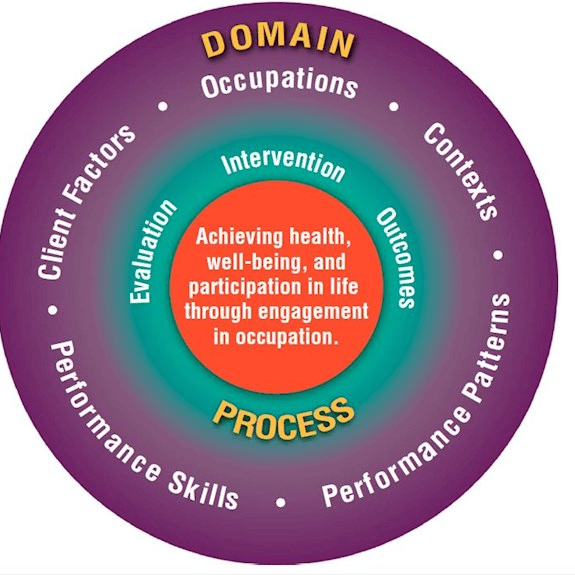Occupational Therapy Founder who introduced
habit training in New York State Hospitals in 1920's
Eleanor Clarke Slagle
The goal to establish a well-balanced day and return the individual to the community if possible is what type of specific training?
Habit Training
Important reminder:
Occupational therapy practitioners are concerned with 4 different types of performance patterns: habits, routines, roles, and rituals.
this type of evaluaton tool allows the client to share data about his perspective regarding his occupational performance.
Self Report
Role Checklist is an example
(remember the other types such as interview and performance base which is used when you may be unable to gather info because the client is unwilling or unable to provide in an interview manner)
This U.S. policy has been cited as moving the health system toward a more integrated, holistic model of care addressing physical and behavioral health needs
Affordable Care Act also known as Obamacare
The PEO Model emphasizes that there are transactional relationships between _______________
the person, environment and occupation throughout lifetime
this movement was initiated in response to industrialization of society and can be described as “reestablishing harmony between environment,
occupation and the person”
The Arts and Craft Movement
What are the Domains of the AOTA Practice Framework (OTPF4)

Occupations
Performance Skills
Performance Patterns
Context and Environment
The domain of occupational therapy includes:
- Occupations (e.g., activities of daily living, rest and sleep, work, and education)
- Contexts (i.e., environmental and personal factors)
- Performance patterns (i.e., habits, routines, roles, and rituals)
- Performance skills (i.e., motor skills, process skills, and social interaction skills)
- Client factors (i.e., values, beliefs, spirituality, body functions and body structures).
The next step after gathering data for a patient ,you have a general overview of the client. The practitioner may use a variety of assessment tools to produce this part of the evaluation _____________
Analysis of occupational performance
(after the analysis of performance the practitioner can now plan an intervention plan based on the clients performance )
In order for an OT practitioner to support individuals in recovery,
focusing on medication compliance
and improving client factors.
are NOT as important as these two ________
1. analysis of occupational performance to identify skills and abilities that support or impede engagement
2. assessment of areas of occupation the individual wants to engage in.
This is at the core of all PEO interactions. It resides in the person,
is shaped by the environment,
and gives meaning to occupations.
Spirituality
This humanistic treatment approach had a major impact on the formation of occupational therapy's philosophy
Moral Treatment of the late 18th early 19th century
Family members , peers, faith groups and allies from social networks . This important factor in recovery process is the presence and involvement of people who believe in the person to recover. What Principle of Recovery does this represent (pge 4 in textbook)
Relational
what are the 3 elements that should be considered when selecting an assessment tool
Utility
Validity
Reliability
making healthy choices that support more than just physical well-being but also supports emotional well-being describes what term
health, as defined by the SAMHSA (Substance Abuse and Mental Health Services Administration)
Occupational performance is impacted by the interrelation between the person, environment, and occupation this congruence can be described as
PEO fit
“habits, routines, roles, and rituals used in the process of engaging in occupations or activities that can support or hinder occupational performance” Under what domain of the OTPF4
Performance patterns
This part of the evaluation summarizes the
person’s occupational history
Occupational Profile
"What matters to the individual" is most important not the expertise of the practitioner.
This is a shared belief of the recovery movement and the practice of occupational therapy
The occupational therapy process has three parts:
Occupational therapy can be broken down into three main parts what are they
Evaluation, Intervention, Outcomes.
the therapist assesses a client's needs, plans and implements interventions to address those needs, and then evaluates the effectiveness of the treatment to achieve desired outcomes.
This explains why you should use a practice model during the evaluation process
It provides a guide to the process through a holistic lense and ensures all areas impacting occupational performance have been addressed.
In the PEO model, The environment is the context where performance takes place . According to this model what are the 4 environmental elements
physical
institutional
social
cultural
see page 40 for an example in practice